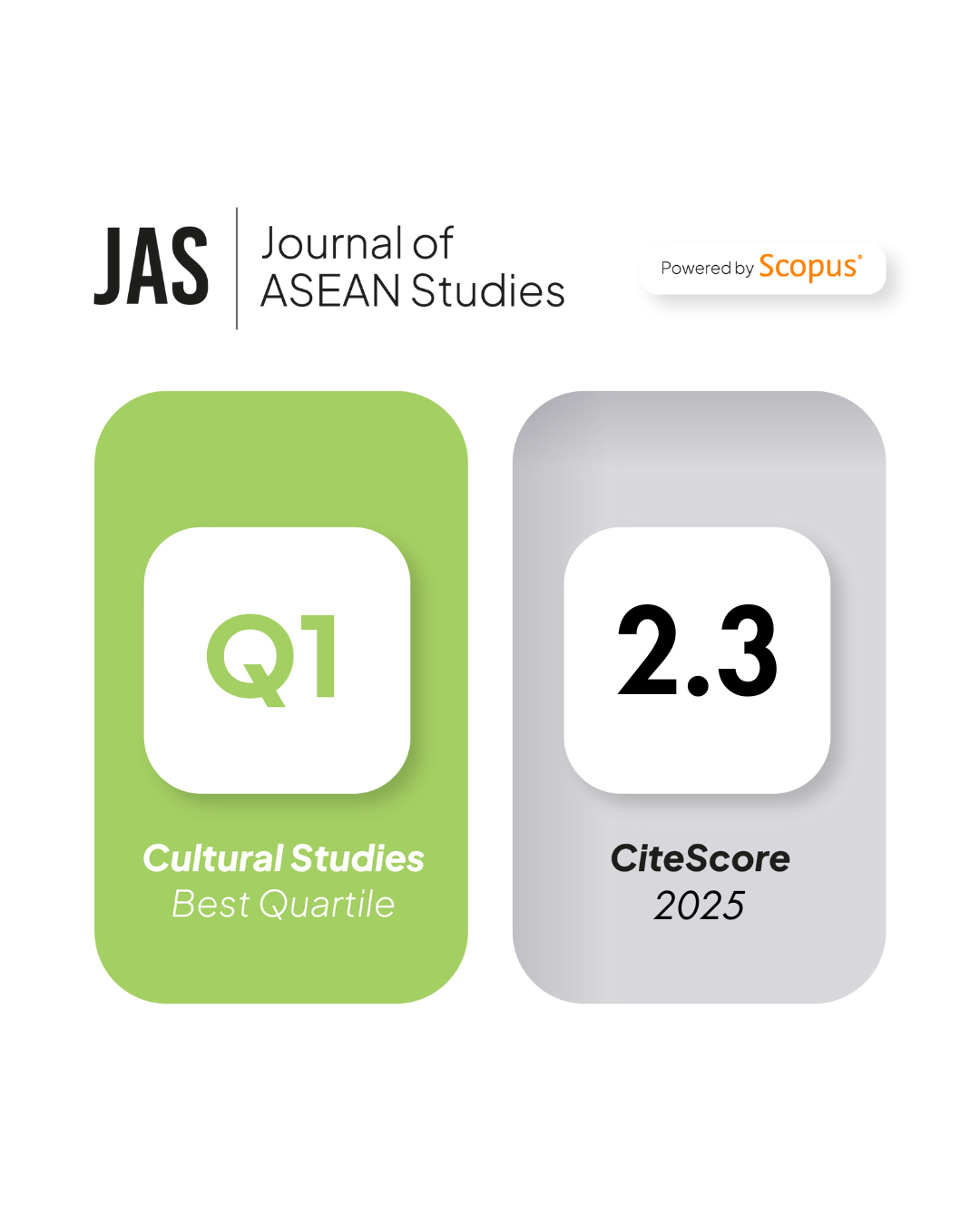How Does Neo-liberalism Explain the Likelihood of China’s Threat Towards United States’ Hegemony in the 21stCentury
DOI:
https://doi.org/10.21512/jas.v4i1.840Keywords:
China, Hegemony, Neo-realismAbstract
By means of neo-liberal perspective and supported by empirical evidences, this essay argues that despite the neo-realists’ assumption of China’s potential threat over the current liberal international system (which is led by the United States as the hegemonic state), China’s tremendous economic rise can be accommodated peacefully for two reasons. The first reason is that China’s economic rise itself is enabled by the existing liberal international system, which perpetuated by the United States’ and its allies. Whereas the second reason is because it is less costly for the one-party-rule China to achieve its national interests by maintaining a cooperative strategic relationship with the United States compared to challenging the United States’ leadership and revising the current liberal international system. This essay will be organized into three main parts. The first part of this essay will elaborate the theoretical debate between neo-realism and neo-liberalism perspectives and their assumptions about the ‘China Threat Theory’. The second part will provide empirical evidences to support the analysis of China’s likelihood to challenge United States’ hegemony in the 21st century based on the neo-liberalism perspective. The third part will analyse the potential of China to become the regional hegemonic power in South East Asia, and then followed by a conclusion.
References
AIIB (2015) “What is the Asian Infrastructure Investment Bank?â€.Asian Infrastructure Investment Bank. Available at http://www.aiib.org/html/aboutus/AIIB/. Accessed on 26 December 2015.
Aiyar, Swaminathan S Anklesaria (2015) “Why US Allies Are Happy to Join China’s AIIBâ€. The Diplomat. Available at http://thediplomat.com/2015/07/why-us-allies-are-happy-to-join-chinas-aiib/.Accessed on 26 December 2015.
BBC (2001) “ China Joins the WTO-At Lastâ€. BBC News. Available at http://news.bbc.co.uk/1/hi/business/1702241.stm. Accessed on 25 April 2014.
EgberinkFenna and Frans Paul Van Der Putten (2011) “ASEAN, China’s Rise and Geopolitical Stability in East Asiaâ€. Clingendael Paper No. 2. Available at http://www.clingendael.nl/sites/default/files/ASEAN,%20China's%20rise%20and%20geopolitical%20stability%20in%20Asia.pdf. Accessed on 26 December 2015.
Folker, Jennifer Sterling (2013) “Neoliberalism†in Tim Dunne, MiljaKurki and Steve Smith. International Relations Theories: Discipline and Diversity. 3rd edition. Oxford: Oxford University Press.pp. 114-131
Foot, Rosemary (2006) “Chinese Strategies in a US-hegemonic Global Order: Accommodating and Hedgingâ€. Foreign Affairs 82.pp. 77-94.
Friedberg, Aaron L. (2005) “The Future of US-China Relations: Is Conflict Inevitable?â€.International Security. Vol. 30. No. 2. pp. 7-45.
Glaser, Charles (2011) “Will China’s Rise Lead to War? Why Realism Does Not Mean Pessimismâ€. Foreign Affairs 90.pp: 80-91.
IBRD (2014) “International Bank for Reconstruction and Development Subscriptions and Voting Power of Member Countriesâ€. Available at http://siteresources.worldbank.org/BODINT/Resources/278027-1215524804501/IBRDCountryVotingTable.pdf. Accessed on 26 April 2014.
IDA (2014) “International Development Association Subscriptions and Voting Power of Member Countriesâ€.Available at http://siteresources.worldbank.org/BODINT/Resources/278027-1215524804501/IDACountryVotingTable.pdf. Accessed on 26 April 2014.
IFC (2014) “International Finance Corporation Subscriptions and Voting Power of Member Countriesâ€.Available at http://siteresources.worldbank.org/BODINT/Resources/278027-1215524804501/IFCCountryVotingTable.pdf. Accessed on 26 April 2014.
Ikenberry, G. John (2011) “The Future of the Liberal World Orderâ€. Foreign Affairs. Available at http://www.foreignaffairs.com/articles/67730/g-john-ikenberry/the-future-of-the-liberal-world-order. Accessed on 16 April 2014.
Karim, Moch Faisal and Tangguh Chairil (2016)‚ 'Waiting for Hard Balancing? Explaining Southeast Asia’s Balancing Behaviour towards China', European Journal of East Asian Studies. Vol. 15, pp. 1-28.
Krasner, Stephen D. (1983) International Regimes. New York: Cornell University Press.
Mearsheimer, John J. (2013) “Structural Realism†in Tim Dunne, MiljaKurki and Steve Smith. International Relations Theories: Discipline and Diversity. 3rd edition. Oxford: Oxford University Press.pp. 77-93
Mearsheimer, John J. (2010) “The Gathering Storm: China’s Challenge to US Power in Asiaâ€. The Chinese Journal of International Politics. Vol.3. pp. 381-396.
MIGA (2014) “Multilateral Investment Guarantee Agency Subscriptions and Voting Power of Member Countriesâ€.Available at http://siteresources.worldbank.org/BODINT/Resources/278027-1215524804501/MIGACountryVotingTable.pdf. Accessed on 26 April 2014.
Nathan, Andrew F. and Andrew Scobell (2012) “How China Sees Ameica: The Sum of Beijing’s Fearsâ€. Foreign Affairs. Vol.32. pp. 32-47.
Panda, Ankit (2015) “Have the US and China Come to an Understanding on the AIIB?â€.The Diplomat.Available at http://thediplomat.com/2015/09/have-the-us-and-china-come-to-an-understanding-on-the-aiib/.Accessed on 27 December 2015.
Roy, Denny (1996) “The “China Threat Issueâ€: Major Argumentsâ€. Asian Survey. Vol.6. No.38. pp.758-771.
The White House (2015) “ Factsheet: US-China Economic Relationsâ€. Available at https://www.whitehouse.gov/the-press-office/2015/09/25/fact-sheet-us-china-economic-relations. Accessed on 28 December 2015.
Scott, James and Rorden Wilkinson (2013) “China Threat? Evidence from the WTOâ€.Journal of World Trade.Vol.47. No. 4.pp. 761-782.
Shambaugh, David (2011) “Coping with Conflicted Chinaâ€. The Washington Quarterly. Vol. 34. No. 1. pp. 7-27.
World Bank (2014) “China 2030 Overviewâ€.Available at http://www.worldbank.org/content/dam/Worldbank/document/China-2030-overview.pdf. Accessed on 25 April 2014.
Xia, Ming (2005) “ "China Threat" or a "Peaceful Rise of China"? â€. The New York Times.Available at http://www.nytimes.com/ref/college/coll-china-politics-007.html. Accessed on 25 April 2014.





















